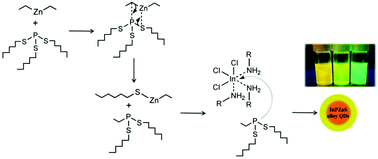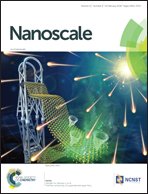InPZnS alloy quantum dots with tris(hexylthio)phosphine as a dual anionic precursor†
Abstract
Recently, InP-based quantum dots (QDs) have received significant attention due to their usefulness in display applications, and the search for good optical properties has led to numerous reports on the testing of reaction variables. However, most researchers have precluded the most important anion precursors in their studies, instead of focusing only on tris(trimethylsilyl)phosphine(P(SiMe3)3, TMS3P) precursors. Due to its vulnerability to moisture, TMS3P is unstable and difficult to handle. In the current study, a new anionic precursor, tris(hexylthio)phosphine(THTP), is introduced for use with InP-based QDs. Owing to its activated phosphine and sulfur atoms, the THTP molecule is a dual anionic precursor for both InP and ZnS QDs. When THTP is reacted with indium and zinc precursors, InPZnS alloy QDs can be fabricated. To observe the synthesis mechanism and probe the intermediate, FAB-mass and 31P-NMR analyses were conducted, resulting in the identification of an intermediate of MW 504. Finally, the surface was coated with a ZnS shell to obtain the emission wavelength from 530 nm to 570 nm and a maximum quantum efficiency of 42% when a ZnI2 precursor was used.



 Please wait while we load your content...
Please wait while we load your content...